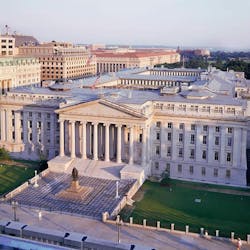Feds Seeking More Clarity Around Eligibility of Microgrid Controllers for Tax Credits
The U.S. Department of the Treasury and Internal Revenue Service (IRS) are clarifying and seeking input for what qualifies a microgrid project for access to more of the investment tax credit (ITC) and funding under the federal Inflation Reduction Act.
The two government revenue entities released new guidance on the ITC to provide “additional clarity and certainty in making investment decisions for clean energy projects,” according to the Treasury press release this month.
The Inflation Reduction Act allocates more than $350 billion toward distributed energy, electrification and microgrid projects nationwide, some of which were announced by the U.S. Department of Energy, developers and utilities in the past few months. This new federal Notice of Proposed Rulemaking includes some added focus around the eligibility of stand-alone battery storage for the ITC as well as the inclusion of costs around the interconnection of projects to the main grid.
Microgrid controllers are under the microscope as the federal entities seek to revise and hone statutory definitions and eligibility questions. The Inflation Reduction Act includes a 30% ITC for microgrid controllers used in eligible projects.
The legislation also added to a part of the microgrid-focused Section 48 to provide some definition of microgrid controllers. The subsection currently defines a controller as equipment that is “part of a qualified microgrid and designed and used to monitor and control the energy resources and loads on such microgrid.”
However, numerous responders sent Treasury and the IRS comments requesting clarification on that definition. Some said it was too broad, others said it was too narrow, while additional commenters asserted that the focus of a qualified microgrid controller should be about the system’s capabilities and not the interconnection with the utility grid.
The proposed new subsection would clarify that an eligible microgrid “includes an electrical system that is capable of operating in connection with the larger electrical grid whether or not the microgrid is physically connected to the electrical grid,” according to the federal document.
Federal Regulators and Clean Energy Champions will be at Microgrid 2024
Happening April 22-24 in Baltimore: Join the Revolution in Energy
Another part of the ITC guidance deals with the so-called “One-Megawatt Exception,” which allows projects with a net output under that capacity to be eligible for the increased tax credit without satisfying the prevailing wage and apprenticeship requirements of larger projects.
This presumably would allow microgrids to take advantage of the One-Megawatt Exception, but perhaps not microgrid controllers themselves.
“Because electrochromic glass property, fiber-optic solar and microgrid controllers do not generate electricity or thermal energy, these energy properties are not eligible,” reads the report. “The Treasury Department and the IRS request comments on whether other methods of measurement may allow these energy properties to use the One-Megawatt Exception.”
Awaiting IRS clarifications on the various components of the Inflation Reduction Act is a key point for developers who want to build billions of dollars in microgrid and distributed energy projects.








